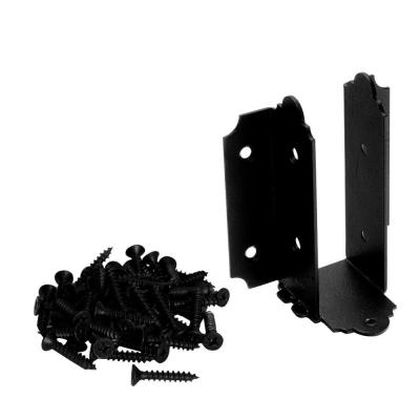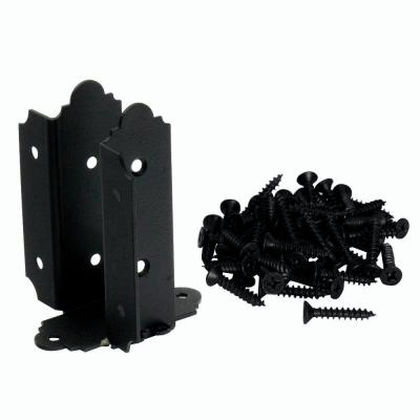Your cart is currently empty.
Continue ShoppingYOUR COMPREHENSIVE JOIST HANGER REVIEW
The simplest way to install strong, stable deck joists is by using joist hangers. This is very important because deck joists must be able to handle a large load over a long period of time.
As a structural and architectural feature, joists are an integral part of any deck. They are a series of repeated structural members that are used in building the deck frame. Specifically, joists are used to hold up the deck floor.
Typically, joists are supported by the building’s foundation, beams, or wall framing. They are usually laid out in a standard but repetitive pattern with the goal of spanning over the whole open space beneath the members perpendicularly. And when you use them on your deck floor framing system, joists make the subfloor sheathing stiff.
The simplest way to install strong, stable deck joists is by using joist hangers.
FEATURED PRODUCTS
DIFFERENT TYPES OF JOIST HANGERS
The term joist hanger is used to refer to the metal brackets that support joist beams and connect them to foundations and walls. Joist hanger types usually vary according to their metal composition, the size of the beam they carry, as well as their design and aesthetic features.
However, the most important characteristic of any joist hanger is its size. Manufacturers usually make wood beam hangers to hold specific pieces of dimensional lumber. Many architects and builders usually refer to joist hangers by their size.
For any joist hanger to support structural framing members safely, it has to be resistant to corrosion. The most common types of rust-resistant joist hangers currently on the market are stainless steel, zinc-plated, and hot dipped.
Zinc-plated hangers go through an electrochemical process that plates a steel frame with rust-resistant zinc. When it comes to hot-dipped joist hangers, they are not electroplated. Instead, they are dipped in a molten vat of zinc. On the other hand, stainless steel hangers don’t get or need any coating. That’s because stainless steel is naturally resistant to corrosion.
A lot of people underestimate just how important it is to select and properly install the right type of joist hanger. But your deck will only be as strong as the weakest connection. Here is a brief run-down of the different joist hanger types that are available to help you make the right decision:
Concealed Joist Hangers
If you have an area that is hard to reach or where it’s almost impossible to attach the side flanges of a typical joist hanger, then your best bet is to use a concealed joist hanger.
This type of hanger is very useful when it comes to attaching rim joists at the edge of a ledger board. Plus, it can also be installed on the edge of the ledger board without the need to nail into the lumber end grain. This is very important because many building codes prohibit this practice.
You can attach concealed joist hangers to the sides of support posts. They can also be used to attach exposed stair stringers for a sturdy and attractive connection, making the great ornamental joist hangers.
45-Degree Angled Joist Hangers
If you are building an angled deck, you may need to use right and left skewed joist hangers. They are usually bent at a 45-degree angle. And the best part is that they can be nailed in place using joist hanger nails using the same technique as you would employ when installing straight joist hangers.
For angled beams, you will need to install double right and left skewed joist hangers. However, these are usually a more expensive option.
Make sure that all your angled joist fasteners are either stainless steel or galvanized with zinc. This will ensure that they can be used with ACQ lumber. Also, you should never try to cut or bend standard joist hangers for use in an angled deck. But we’ll get more into that later.
Wood Joist Hanger
A wood joist hanger is specifically designed for use in building wooden or treated lumber decking. They provide support underneath the joist to give you a strong, stable connection.
If you are using these joist hangers for an outdoor project or a place that has a lot of humidity and moisture, then it might be a good idea to go for stainless steel or zinc-coated options. This ensures that your deck will have extra protection from damages caused by rust and corrosion.
I-Joist Hanger
An I-Joist is a type of joist that is made out of engineered wood. This product was designed to get rid of the problems that crop up when using normal wood joists. When compared to their size, i-joists are very strong. This means that they can carry much heavier loads with less lumber than a solid wood joist.
Apart from that, i-joists have also become quite popular in building circles because they are less likely to bow, twist, crown, or split. They also don’t shrink quite as much, which ensures that you’ll never have squeaky floors again.
However, i-joists must be installed correctly to ensure your deck’s structural integrity. The best way to do this is by using I joist hangers. These are specifically designed to be used when installing i-joist beams.
You use an I joist hanger to avoid common installation mistakes like improperly sizing or misplacing holes in the web, and improper nailing. These mistakes can compromise the strength of your i-joist beams, which could easily lead to structural failure.
WHAT IS THE JOIST HANGER TAB?
A joist hanger tab is a feature that is included in some joist hangers to help you make the necessary adjustments during installation. These adjustable tans are used during traditional attachment methods to make sure the joist hanger fits securely and snugly. A great example of a product that has this great feature is the Laredo Sunset Joist Hanger Tab 6” – 8” and the Ironwood Joist Hanger Tab 6” – 8”.
WHAT IS A JOIST HANGER FLUSH?
These joist hangers are designed to fit in seamlessly with your deck. They don’t have any tabs or other modifications, ensuring that they end up fitting perfectly flush with the joist it attaches to, as well as the ledger flashing.
Apart from their structural features, these decorative joist hangers will also make your deck aesthetically pleasing.
The best examples of joist hunger flush include the Laredo Sunset Joist Hanger Flush 6” – 8”, Ironwood Joist Hanger Flush 6” – 8”, and the Laredo Sunset Flush 8” – 10”.
SIZING JOIST HANGERS
Determining the best joist hanger size to use can be a bit involving. First, you have to think about the number of joists that will be installed. Generally, joists that are spaced 16” from the center can span 1.5 times (in feet) their depth (in inches). So, a 2×10 joist can span up to 15 feet, for example.
What this means is that larger decks will require more joists. The size of the actual joists depends on your deck size as well as the general spans that we’ve mentioned above.
So, how do you use this information to pick joist hanger dimensions?
Here’s a great rule of thumb to follow: always use the largest joist hanger size to install any joist. These hangers are designed for specific applications, and each offers a different load carrying capacity. For instance, 4×4 Joist Hangers can offer a minimum load capacity that is different from the 4 X 8 Joist Hanger.
But here’s the bottom line: it all depends on the type of deck that you’re building as well as the decking material that you’re using. Because of all these factors, it might be a good idea to consult a professional before making any purchases.
Bonus Tip: Never Modify Joist Hangers
For some builders, modifying joist hangers by bending, cutting, or adjusting them is standard practice. However, this is a pretty dangerous habit. Not only can it compromise the structural integrity of your deck, but it also makes all the manufacturer’s guarantees about the hangers performance null and void.
Straight joist hangers are specifically designed to hold joists at a 90-degree angle. On the other hand, angled hangers can only support joists at a 45-degree angle.
If these aren’t a good fit for the project you’re working on, there are many other options to choose from. You can find hardware to fit with almost any kind of application that you can imagine. So, do your research to find the best connector for your project.
WHAT SIZE NAILS SHOULD YOU USE FOR JOIST HANGERS?
To get the full load-bearing capacity of any joist hanger, it is important to use the right nail. The nail’s size and length really do matter. Installing the right one will also give you joist the much-needed strength and stability.
When you’re doing interior framing, it is best to use the thicker 1½” common nails to fasten your joist hangers. These types of nails include the 10d, 12d, and 16d ranges.
For outdoor installations – such as decks – the best option is to use 1½” 16d nails that have been double-dipped and galvanized. You can also go for stainless steel nails if the project calls for it.
HOW TO INSTALL JOIST HANGERS FOR A DECK
- Start off by making a scab guide. To do this, just screw a short piece of wood on top of a section of your joist material.
- Place the guide on top of the joist board that needs to be fastened. Ensure that the guide is in alignment with the layout line. This will keep it straight vertically.
- Slip on a joist hanger to support the guide. You can then pound in the barbed tips on the joist hanger to hold it in place.
Alternatively, you could drive a nail at the top end of the joist and bend it over to hold the joint flush with the other beam. Ensure that the joist is aligned with the layout line.
- Then, remove the guide and drive in some nails to attach the hanger to the beam.
- Finish by slipping the joist into the hanger, then drive in the nails that go into the joist.
Bonus Tips:
Most joist hangers usually have barbed tabs to help you hold the hanger in place temporarily. However, most people don’t like using these because they do not hold well enough to be reliable.
Another thing to keep in mind is that you must use short joist hanger nails for the installation. Never use roofing or other nail types. That’s because joist hanger nails are usually extra strong to offer the required shear strength.
CONCLUSION
Joist hangers are a great addition to any decking project. Not only do they ensure that your deck is structurally sound, they also provide an added element of aesthetic appeal.
But you have to use the right type and size for your particular project. This is the only way to ensure that you get all the benefits that joist hangers have to offer.
 Visit USA Site
Visit USA Site


